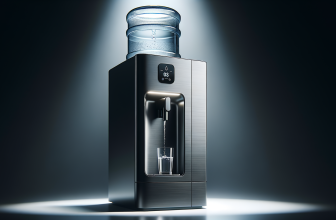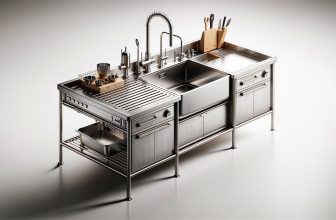
Ever thought of how delicatessens slice hams, salamis, or even your favorite roast beef so perfectly every time? The secret is in their commercial meat slicers, an indispensable tool for both food businesses and home cooks who love precision and efficiency. But as a home chef, do you know which meat slicer is the best fit for your kitchen? The best meat slicer should provide a combination of power, safety features, durability, and ease of cleaning.
Our Top Picks
Our #1 Top Pick: Chef’sChoice 615A Electric Meat Slicer
The Chef’sChoice 615A stands out for its versatility and rugged construction. With a powerful, high-torque electric motor, this slicer can handle various meats with ease, even those with a denser texture. It features precision thickness control, allowing you to slice from deli-thin to approximately 3/4-inch thick slices. The stainless steel blade measures 7 inches, ideal for cutting many kinds of food. For safety, it includes a lock feature to limit access to the blade when not in use. Cleaning is straightforward as the components that come into contact with food all remove easily.
Pick #2: BESWOOD 10″ Premium Chromium-plated Electric Meat Slicer
The BESWOOD meat slicer cuts through meat like butter, thanks to its chromium-plated blade, which is known for its resistance to corrosion and long-lasting sharpness. It boasts a powerful motor and a built-in sharpener, ensuring your blade remains razor sharp for effortless slicing. A remarkable feature is its noise and vibration reduction technology, which makes your slicing experience more pleasant. The slice thickness is easily adjustable, and despite its professional-grade capabilities, it is relatively compact and fits well in a home kitchen.
Pick #3: Cuisinart FS-75 Kitchen Pro Food Slicer
Cuisinart’s FS-75 slicer is a perfect option for those looking for a balance between commercial-grade quality and home kitchen convenience. This slicer comes with a 7.5-inch stainless steel blade and can handle various slicing tasks without oversized footprints of professional slicers. It also features a handy control knob for adjusting slice thickness. While it doesn’t boast the same power as some others on the list, it performs admirably with most meats and is a good value-for-money choice.
Pick #4: Kitchener 9-inch Professional Electric Meat Slicer
The Kitchener 9-inch Meat Slicer boasts an impressive combination of performance and safety. Its ability to power through meats and even some cheeses is attributed to its high-quality 9-inch blade and reliable belt-driven electric motor. It includes a removable ring-guard cover to prevent debris buildup on cutting surfaces and features a waterproof on-off switch. The thickness-adjusting knob makes it flexible for cutting to your desired preference, and its suction cup feet ensure stability during operation.
Pick #5: Weston 7.5-Inch Stainless Steel Food Slicer
Weston’s slicer gives you reliable performance with a slightly smaller blade size, making it a good choice for those with less counter space. The high-quality, rotary 7.5-inch stainless steel blade provides superb precision and durability. One of the slicer’s strong points is its sturdy base and suction cup feet, which help prevent slipping. The slicer is also relatively simple to disassemble for cleaning, and the thickness control allows for slicing from deli thin to over 1/2 inch thick.
What to Know Before You Buy
- Motors and Power: The strength and build of the motor determine how easily the slicer can cut through different types of meat. A sluggish slicer can lead to shredded and unevenly sliced meat.
- Blade Size: Blade sizes typically range from 7 to 14 inches. Larger blades are meant for more frequent use and tougher slicing jobs, while smaller blades can take care of occasional slicing at home.
- Safety Features: Look for slicers that offer features like blade guards, non-slip feet, and lockable switches to prevent accidental cuts and ensure stability during use.
- Easy Cleaning: Models that allow for simple disassembly without tools are much easier to clean and maintain, ensuring you can keep the slicer hygienic after each use.
- Thickness Control: Adjustable thickness control allows you to slice your meats as thin or thick as needed, which is essential for preparing a variety of dishes.
- Construction Materials: Stainless steel and die-cast aluminum construction is preferable for durability and long-lasting use.
- Noise: Some slicers can be quite loud, which may be a concern if you’re sensitive to noise or will use the slicer frequently.
Factors to Consider Before Buying
- Size and Space: Consider how much space you have in your kitchen. Some slicers can be bulky, so it’s important to measure out the intended storage space.
- Frequency of Use: Assess how often you plan on using the slicer. If you’ll be using it frequently, it might be worth investing in a professional-quality slicer.
- Types of Meat: Consider the types of meat you will be slicing. Some slicers are better suited for specific kinds, such as cured meats, whereas others can handle a variety of textures and densities.
- Price: While higher-priced slicers typically offer better quality and durability, determine your budget and find the best slicer within that price range.
- Warranty: Look for products that come with a warranty to ensure you’re covered if any issues occur.
Why Trust ChooseRight?
Our recommendations come from a rigorous evaluation process. We understand the importance of investing in kitchen gadgets that are reliable and get the job done without fuss. To curate our list of the best meat slicers, we’ve read through thousands of reviews from verified customers, matched these insights against the claims of numerous manufacturers, and sought feedback from professional chefs who know their way around a meat slicer. We have done the hard work, so you don’t have to, leading you directly to the tools that can enhance your cooking experience.
Finishing Thoughts
A meat slicer can transform your kitchen experience, providing uniform slices of meat for your dishes, saving you time, and giving professional results. Whether it’s for making sandwiches, preparing charcuterie boards, or cooking, the right slicer can make all the difference. Remember to reflect on the factors and considerations shared before making a purchase. With the right meat slicer, you are not just buying a kitchen appliance; you are investing in quality and efficiency that can elevate your cooking to the next level.
Frequently Asked Questions
What is a meat slicer and why do I need one?
A meat slicer is a kitchen appliance designed to slice meats uniformly in various thicknesses. It is necessary if you require consistent slices for sandwiches, recipes, or preserving meats, and is especially useful for those who buy in bulk or enjoy deli-style meats.
Are electric meat slicers better than manual ones?
Electric meat slicers are generally faster and require less effort to operate than manual slicers. They’re better for those who need to slice large quantities of meat. However, manual slicers offer more control and can be used without electricity, which some may prefer for specific tasks or settings.
How do I choose the best meat slicer for my needs?
Consider the following when choosing a meat slicer: the amount and frequency of meat you plan to slice, desired thickness, space for storage, ease of cleaning, safety features, and your budget. Different slicers offer various features tailored to both personal and commercial use.
Can I slice foods other than meat with a meat slicer?
Yes, many meat slicers can also handle slicing a variety of other foods such as cheeses, bread, vegetables, and even fruits. However, check the manufacturer’s recommendations as not all slicers are designed to handle non-meat items.
What safety features should I look for in a meat slicer?
Important safety features include a blade guard, non-slip feet, a comfortable grip handle, and a locking blade or carriage when the machine is not in use. Some models also offer finger protection and emergency shut-off capabilities.
How do I maintain my meat slicer to ensure its longevity?
Regular cleaning and maintenance are essential. This includes sanitizing the slicer parts that come into contact with food, lubricating moving components, ensuring the blade is sharpened, and checking for wear and tear on the parts. Always follow the manufacturer’s instructions for specific maintenance recommendations.
Is it difficult to sharpen the blade of a meat slicer?
Many slicers come with built-in sharpeners or easy methods for sharpening the blade. If you’re not comfortable doing it yourself, you can also have the blade professionally sharpened. Check the manual for instructions on how to sharpen your model’s blade or for recommended service providers.
What thickness settings do meat slicers typically have?
Meat slicers often offer a wide range of thickness settings, from deli-thin to around ¾ of an inch thick. Some commercial slicers may provide even broader options. The thickness is adjusted by a control knob on the machine.
How do I properly clean my meat slicer?
Unplug the slicer, remove parts that are meant to be taken out for cleaning, and follow the manufacturer’s guidelines for cleaning each component. Use a mild detergent and warm water, and avoid abrasive cleaners that could damage the slicer. Make sure all parts are dried thoroughly before reassembly and storage.
What price range can I expect for a good quality meat slicer?
The price can vary widely based on features, brand, and quality. Household slicers can range from around $50 to $300, while commercial slicers can go from a few hundred dollars to several thousand. Determine your needs and budget to find a slicer that offers the best value for your requirements.







